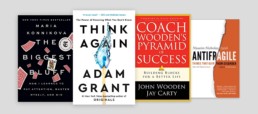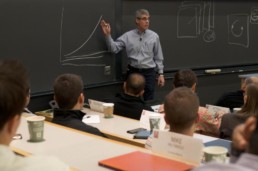The Best Books About Entrepreneurship That Are Not About Entrepreneurship
The Disciplined Entrepreneurship Toolbox
Stay ahead by using the 24 steps together with your team, mentors, and investors.
Sign up for our newsletter
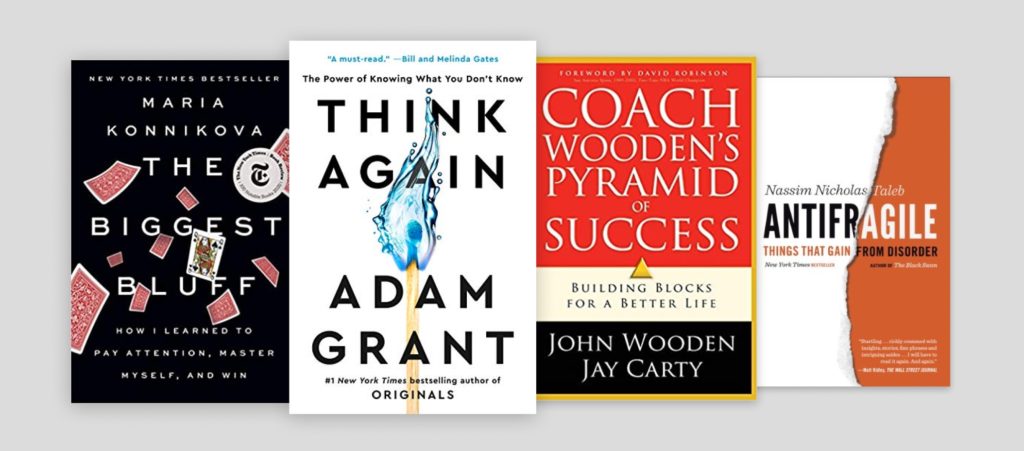
Over the past 12 months, I have had a chance to do more reading. Among the titles I’ve flipped through, I’ve read two great books on unrelated topics that are actually about entrepreneurship. This is not uncommon as some of the best insights we get come from lateral thinking and learning.
Two books that fit this category that immediately come to mind for me are “Coach Wooden’s Pyramid of Success” by legendary college basketball coach John Wooden, and “Antifragile” by Nassim Nicholas Taleb. Both had a profound impact on how I think about and execute entrepreneurship. I encourage myself and you to not take everything in a book as correct and applicable, but in great books, we can find a few insights that profoundly improve our understanding of the world and, in the context of this article, entrepreneurship.
But the two books I read recently that have impacted my thinking are “The Biggest Bluff: How I Learned to Pay Attention, Master Myself, and Win” by Maria Konnikova, and “Think Again: The Power of Knowing What You Don’t Know” by Adam Grant. I highly recommend them to all entrepreneurs to continue to improve their game.
The Biggest Bluff: How I Learned to Pay Attention, Master Myself, and Win
Maria Konnikova, the author, is clearly a non-conformist in a positive manner; the pirate we talk about and cherish. She is determined to better understand the connection and role of skill and luck. How much of your success as an entrepreneur is related to randomness and luck, and how much to your skills and personal characteristics? Guy Raz on his wildly successful podcast about entrepreneurs called “How I Built This” asks this question to every guest. While I generally enjoy the podcast and stories of entrepreneurs, I find this question annoying. But it is an important one to consider.
Maria does a brilliant job of framing this duality and then, incredibly appropriately and fearlessly, ventures into the world of professional poker playing to find out. When I say she jumps in, she jumps in! She does not just observe, she becomes a professional poker player. While the self-reflection can be meandering at times, don’t give up. There are incandescently brilliant parts where Maria comes to grip with this dichotomy and learns how to tame it.
I have heard people say that to be a great entrepreneur you have to never give up. What terrible advice! Almost the exact opposite is true. To be a great entrepreneur, you have to know when to fold and when to pivot on an idea because it will never be completely true. That does not mean that grit and perseverance are not a critical component of success—they absolutely are—but they have to be done intelligently. Some things are beyond your control.
Just as a great poker player does not always win, great entrepreneurs don’t either. You have to play the long game and know when to fold in the short term at a minimum. Maria did a wonderful job of making this point very clear and how to move forward in a positive manner and not be frozen by the challenge.
I don’t think they ever even mention the word entrepreneurship in “The Biggest Bluff,” but to me, it was the best book of 2020 on the subject because of the reasons above.
Learn more and get the book here
Think Again: The Power of Knowing What You Don’t Know
Even though we’re only two months into 2021, the bar is already incredibly high. From my standpoint, the book to beat is “Think Again” by Adam Grant. I really enjoyed his book “Originals: How Non-Conformists Move the World,” which had already been on my recommended book list, but this new title is even better. Adam is a Wharton Professor with a Ph.D. in Psychology; not your traditional path for someone to comment so powerfully on entrepreneurship, but don’t be fooled.
The book starts out right away in the first chapter with a compelling and well-written case for iterating. While he does not mention it explicitly, that is the core of entrepreneurship. Every starting hypothesis we have is incomplete and almost assuredly wrong, so the essence of entrepreneurship is coming up with good hypotheses to start and then intelligently and quickly iterating on them to make them better and better.
Adam integrates so many studies with data but also effectively interprets and questions the studies to arrive at reasoned conclusions. He is able to communicate his theses with examples and great storytelling techniques. He is truly a gifted writer and, while I have less direct evidence, an educator as well.
While the focus is not on entrepreneurship, “Think Again” does give multiple entrepreneurship examples that make connecting the dots easier for our context. There is a lot in the book about entrepreneurial leadership as well as the process that is invaluable (I especially like Chapter 9 in this regard). While most books have what I consider lesser chapters or ones that I think are wrong or not particularly useful to the reader, I felt like “Think Again” was very strong to the end. It was so valuable that I intend to go back through it and read it again, which I rarely do, and try to incorporate a lot into my teaching this spring.
Learn more and get the book here
Both “The Biggest Bluff” and “Think Again” will be added to our list of recommended books immediately and I highly recommend them to you as you continually improve your entrepreneurial mindset, skillset, and way of operating. As mentioned at the beginning, often the best ideas come from looking around you as opposed to straight ahead.
The author
Bill Aulet
A longtime successful entrepreneur, Bill is the Managing Director of the Martin Trust Center for MIT Entrepreneurship and Professor of the Practice at the MIT Sloan School of Management. He is changing the way entrepreneurship is understood, taught, and practiced around the world.

The books
This methodology with 24 steps and 15 tactics was created at MIT to help you translate your technology or idea into innovative new products. The books were designed for first-time and repeat entrepreneurs so that they can build great ventures.

In Difference Podcast: DE in the Public Sector
Bill Aulet
On Tuesday February 2, 2021, from 11 am-noon Boston time, Bill Aulet will be doing “In Difference Podcast” with Mark Roe (moderator) and Corina Hanrahan (the City and County Council of Limerick, Ireland) on how Disciplined Entrepreneurship is being applied in the public sector.
Attend on Zoom: https://ucd-ie.zoom.us/j/67812307854
Sign up for our newsletter
The books
This methodology with 24 steps and 15 tactics was created at MIT to help you translate your technology or idea into innovative new products. The books were designed for first-time and repeat entrepreneurs so that they can build great ventures.

Entrepreneurship & Antifragility MOOC on edX
Bill Aulet
Thursday, January 28 is the scheduled release of the new edX MOOC “MITx: 15.S19x: Cultivating Entrepreneurship & Antifragility to Thrive in a Fast-Paced World”. Upon completion, you can earn a certificate, probably the first-ever in Antifragility and certainly the first from MIT in Antifragility.
Sign up for our newsletter
The books
This methodology with 24 steps and 15 tactics was created at MIT to help you translate your technology or idea into innovative new products. The books were designed for first-time and repeat entrepreneurs so that they can build great ventures.

Characteristics of Winners in the COVID Crisis: Six Lessons Learned from Zoom, Peloton, and Grubhub
Last month as things started to wind down for the holidays and lecturing in classes slowed down, I had the exciting opportunity to host the CFOs from Zoom, Peloton, and Grubhub at the MIT CFO Summit and the CFO Leadership Council Conferences. This was a great chance to talk directly with leaders in some of the real rocket ships in this COVID crisis. These are three poster examples of companies who have seen effectively managed the dramatic market shifts to more digitalization as was highlighted on the front page of The Wall Street Journal at the same time.
Let me summarize six key lessons learned from analyzing what made them so successful:
- Understanding how technological capabilities are changing.
All saw the possibilities from the evolving technological advancements but that was necessary but wholly insufficient on its own. - Understanding changing consumer behavior patterns.
Just because something is possible, does not mean customers will adopt it. You need to understand customer habits and if they are open to change, which generally they are not… unless… - Building an organization with the capability to realize this opportunity.
The companies vision is that something will be possible and it will be adopted by customers over time. The question is “When?”. You have to put yourself in a position to capitalize on the changing trends in #1 and #2 above but not bet on a specific time. It usually takes much longer than it seems it logically should (in B2C and B2B). Put yourself in a position to capitalize with a strong organization and resources but not too many resources that you lose your muscles to listen to customers very carefully. Creating new markets and changing customer buying habits is very hard and takes time. You can’t just listen to what customers say they want in terms of product, you have to understand their *real* underlying problem and continually validate that you can address it even if their embrace of your efforts is not as complete and as widespread as you would like. Believe in the vision of what these trends are telling you but do not get ahead of yourself in counting on customer adoption faster than they are willing to accept. Push the frontier with a market segment (your beachhead market) but also have patience. - Recognizing a window of opportunity when it comes.
Sometimes, luck will fall your way, and there will be something to disrupt the status quo. These often represent outstanding opportunities to change behavior and habits for the better. You must recognize them immediately and capitalize on them. We talk extensively about this in Step 13A in the Disciplined Entrepreneurship Workbook. Realize this is your time and you must invest to take advantage of this finite window and if you miss it, your investments in customer acquisition afterward will likely be at best much less efficient and likely a waste of resources. You must seize the moment. - Moving fast—clock speed is critical.
The speed with which you can iterate with customers once you get the opportunity in this window is critical. One of my favorite quotes is from Thomas Edison who said something to the effect that the measure of innovation is how many times one can iterate on a new idea within 24 hours. You have this golden, perishable opportunity and you have to deliver, be responsive, and win their trust. Be humble, hungry, and even more hardworking during this unique time. - Being data-driven:
In his book That Will Never Work, Marc Randolph talks about how “nobody knows anything.” All we can bring to the discussion to start is a well-reasoned hypothesis but we need to then test it with data. Great companies like Netflix, Amazon, Google, and others use data religiously to tell if the hypothesis is right (or what we call Step #23 “show the dogs will eat the dog food”). Peloton, Zoom, and Grubhub, not surprisingly, also strongly embrace this approach.
Now that I have given you the lead, let me explain how I got there and dive a bit deeper. (It should be noted that Marius Ursache is the editor of this website and when I first sent him my blog post, he wisely suggested that I not “bury the lead.” Maybe I am getting more academic without even noticing so I rewrote to bring the six points to the top.)
I agreed to moderate the fireside chats/interviews because I was interested to see firsthand if they had seen the opportunity coming and intentionally prepared in a way that would be instructive to others. I was also anxious to see what they did they separated them from their competitors. Lastly, I was interested in any other lessons to be learned that could be translated to other situations on how to be more “resilient plus” (the new term for “antifragile”).
On the first point, for all three companies, they saw the megatrends changing in their favor but even so were caught by surprise by how it was all dramatically accelerated by the pandemic. Weren’t we all! They had no special insight at the micro-level. They were all however completely committed to the future of dramatically more digitization so they had a head start for sure. So the answer to the first question above is that they did not succeed because they had brilliant insight with regard to a crisis like this happening, it just happened to support their existing thesis. Like everyone else, they were caught off guard.
Secondly, what separated them from their competitors seems clear to me was their attention to the data signals and the clock speed with which they adjusted. It was also very reassuring to see that they all did so with empathy. By this I mean, they were not trying to profiteer but really thought hard about the impact it was having on their customers and broader society. Zoom made its platform available for free to over 100K schools very quickly. Grubhub thought deeply about the ramifications on their restaurant owners as well as the consumers and made the conscious decision to forego short-term profits to help the communities deal with their very deep and serious challenges.
It should be noted that all of these companies had sufficient resources – cash on the balance sheet – to think longer-term which is a luxury but one earned by disciplined execution. This had put them in a place where they were not vulnerable or fragile to sudden challenges. Very smart and not an accident. It should also be noted that they did not have so much money – see WeWork as the grossly extreme case of this – that they had lost their discipline. They were financially frugal but also had built a buffer so they could be resilient. This kept them hungry, humble, and in touch with the market place.
What was strikingly clear in talking to all of these companies is that they were not some sort of super visionary led companies with a Steve Jobs-like character at the top talking about dramatic changes that no one else was seeing yet, they were driven by data. The most important data was with regard to customer engagement and adoption by market segment. They also noted that dramatic changes in CAC/CoCA as well. In the heat of this crisis, the story of success on these gold standards of excellence is not some special crystal ball or insights by a futuristic guru making big risky bets, it was about understanding the market place and adapting quickly.
A great example of this was Zoom and security. While sales were taking off for this company early on, there were competitors chomping at the bit to take them down. Product and service shortcomings were certain to be exposed and highlighted by analysts and competitors. The newfound spotlight created more scrutiny than they had ever had before. There were features and usability shortfalls that needed to be taken care of and Zoom did an outstanding job addressing these rapidly.
The existential threat came with the security challenge. Starting in April, the media questioned with great intensity and great specificity the security of Zoom and it was not clear if Zoom was going to survive this valid question. The company responded with speed and force not by attacking the messenger but by addressing the problem. They made security a top priority and systematically came out with new features (including buying a security company) at a pace unimaginable just a few years (if not last year). While the issue has not gone away and should not, it is no longer the proverbial Sword of Damocles dominating every conversation about Zoom. Honesty in reading the market, willingness to acknowledge weaknesses, speed to address and disciplined execution are what have kept Zoom on top.
So this is how I got to the six lessons above in the lead. Knowing the principles above and executing them successfully, no matter if the crisis is COVID or anything else, is good counsel to help make you and your organization more “resilient+” (the “artist” formerly known as antifragile).
The author
Bill Aulet
A longtime successful entrepreneur, Bill is the Managing Director of the Martin Trust Center for MIT Entrepreneurship and Professor of the Practice at the MIT Sloan School of Management. He is changing the way entrepreneurship is understood, taught, and practiced around the world.

The Disciplined Entrepreneurship Toolbox
Stay ahead by using the 24 steps together with your team, mentors, and investors.
The books
This methodology with 24 steps and 15 tactics was created at MIT to help you translate your technology or idea into innovative new products. The books were designed for first-time and repeat entrepreneurs so that they can build great ventures.

Best of 2020: My Personal and Readers' Favorite Articles on D-Eship.com
What a year 2020 was!
With my basketball friend, we often end emails with the phrase “stay in your stance.” This is what basketball coaches say to their players so they are always “ready” for anything and don’t have to “get ready,” because if they have to “get ready,” it is probably too late.
With all the adversity and challenges, it has become clearer that entrepreneurship needs to be more broadly embraced beyond just startups. It is crucial for society and not just the individuals doing it. The concept of antifragility (now we call resilience+) took hold in an amazing way. For example, we have already had over 30K views (and that number goes up every day) of our Antifragile Entrepreneurship Speaker Series with literally zero market dollars spent to promote it.
It was a year that tested us and made us stronger in the end. I am completely confident that these newly enhanced (and maybe found) muscles will make us more successful when we get to the other side of the awful pandemic. While we would never wish for a crisis, good can come out of them if we approach them properly.
With that perspective, what were our favorite articles of this past year on this web site? There were so many great ones but my personal favorite was “What Gives Me Confidence That We Are Successfully Teaching Entrepreneurship.” It was so important to me because it really proved to me that what we are doing has a significant impact. I always believed strongly that it did because I see the examples every day with my own eyes but it was good to have such concrete and compelling data to prove this. I must admit as well, while I was very confident, the numbers exceeded even my high expectations.
But each of us probably has our different favorites because of our individual perspectives and interests but it is interesting to see what the top ten were from the consolidated “voting” (voting was done with your clicks specifically, what articles did you view). Without further ado, here are the top ten viewed posts of 2020 (let the arguments or agreements begin in the chat area):
- The LTV Calculation Spreadsheet (Joe Gibson);
- Teaching Entrepreneurship, Cultivating Antifragility (Bill Aulet);
- Disciplined Entrepreneurship “vs.” Lean Startup “vs.” Business Model Canvas (Marius Ursache);
- The MIT Antifragile Entrepreneurship Speaker Series (Bill Aulet);
- How the Antifragile Entrepreneur Can Improve with Improv (Mike Grimshaw & Nate Lee);
- The New Disciplined Entrepreneurship Toolbox (Marius Ursache);
- What Gives Me Confidence That We Are Successfully Teaching Entrepreneurship (Bill Aulet);
- That Will Never Work: The Birth of Netflix and the Amazing Life of an Idea (Bill Aulet);
- Using Disciplined Entrepreneurship with Established Teams (Mark Riddley);
- The Best Technology Does Not Win. A Business Succeeds Because of People (Bill Aulet).
What one do you feel was overlooked? What do you agree with?
Congratulations to Joe Gibson of Clemson for getting #1 of 2020. We welcome your contributions for 2021 as our goal is to continue to build this global, electronic community. If you want to contribute, please get in touch!
Welcome to 2021 and be resilient+!!!
The author
Bill Aulet
A longtime successful entrepreneur, Bill is the Managing Director of the Martin Trust Center for MIT Entrepreneurship and Professor of the Practice at the MIT Sloan School of Management. He is changing the way entrepreneurship is understood, taught, and practiced around the world.

The Disciplined Entrepreneurship Toolbox
Stay ahead by using the 24 steps together with your team, mentors, and investors.
The books
This methodology with 24 steps and 15 tactics was created at MIT to help you translate your technology or idea into innovative new products. The books were designed for first-time and repeat entrepreneurs so that they can build great ventures.

A Time of Crisis Is Not Something an Entrepreneur Survives, It's the Reason Why You Are an Entrepreneur
Berlin is a city that has always intrigued me.
When I graduated from college and had just played a season of pro basketball (don’t be fooled, the pay was not great but I did get paid to play basketball so I am not complaining) in England, I headed to the European continent to explore. I had never been so far from home before. As I hitchhiked across Europe, I headed to Berlin which was then behind the Iron Curtain, meaning it was in the middle of communist Eastern Germany. That experience blew my mind. I even traveled to East Berlin to see how they lived there and had beers with some locals, which was very interesting because I did not speak German and they did not speak English.
Berlin was absolutely bursting with energy on all sides. A wild frontier for sure. That was 1981.
Fast forward to 2010… I have become good friends with Thomas Andrae, the Director of 3M Ventures, and we are doing a lot of productive things together. One of his employees, Dominik Guber, comes to MIT and becomes an absolutely memorable student and successful entrepreneur who I use as one of my case studies in my class today. Thomas got me to travel to Berlin to see the burgeoning entrepreneurial ecosystem there and I was hooked again. The energy and heterogeneity were just like I had remembered it but translated into the current world of entrepreneurship. We had the Technical University of Berlin team in one of the first MIT delta v cohorts as a result.
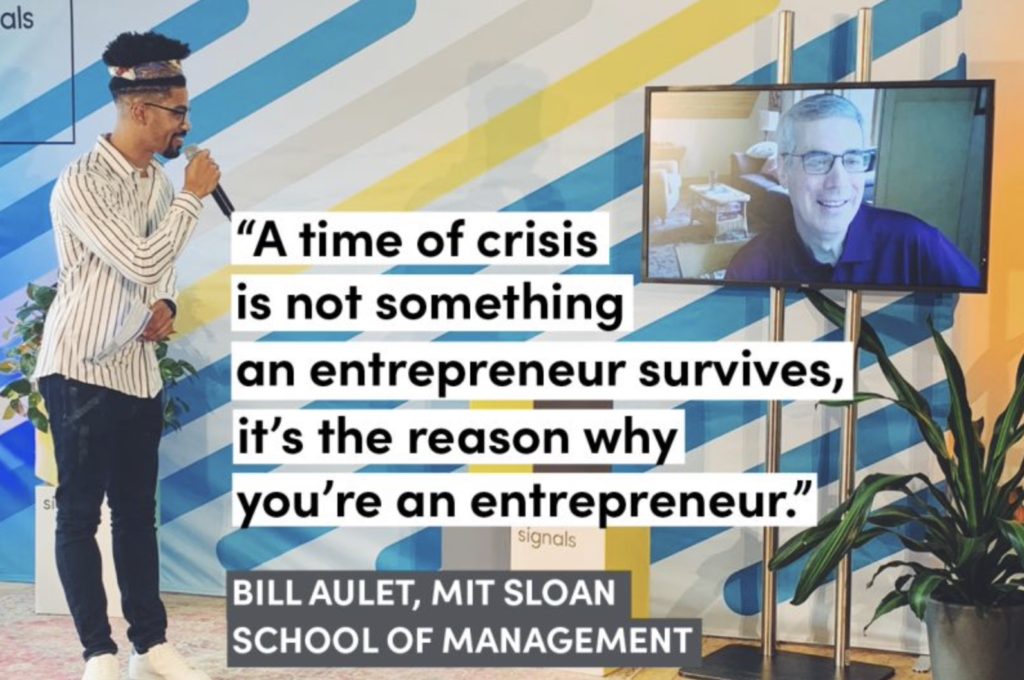
I think of Berlin as a very unique city. Like London is not really an English city but an international city, the same is true for Berlin. It is a place of convergence for all kinds of people. I have gone back a number of times and it never lets me down. One of the visits was to give a talk for the opening of Signal Iduna’s new entrepreneurship and innovation center called “Signals”. It was an accelerator, incubator, educational platform, funder, and more wrapped into one. It was a very innovative ecosystem for entrepreneurs.
I was very pleased and honored when they asked me this year to speak at their annual conference even if I couldn’t travel to Berlin. Once again, it was very energizing and my talk is below – and as you can see from the picture, it was not a corporate outing at all.
Thanks to Signals, Thomas, Dominik, and all my friends in Berlin. As President John F. Kennedy said, “Ich bin ein Berliner“.
The author
Bill Aulet
A longtime successful entrepreneur, Bill is the Managing Director of the Martin Trust Center for MIT Entrepreneurship and Professor of the Practice at the MIT Sloan School of Management. He is changing the way entrepreneurship is understood, taught, and practiced around the world.

The Disciplined Entrepreneurship Toolbox
Stay ahead by using the 24 steps together with your team, mentors, and investors.
The books
This methodology with 24 steps and 15 tactics was created at MIT to help you translate your technology or idea into innovative new products. The books were designed for first-time and repeat entrepreneurs so that they can build great ventures.

The Best Technology Does Not Win. A Business Succeeds Because of People.
Last week, I had the opportunity to give a keynote talk at the Open Innovations virtual forum run by Skolkovo. It was a great chance for me to go back and not just talk about Disciplined Entrepreneurship but also to see the progress Skolkovo University has made in the area of entrepreneurship in Russia. On the panel with me was Kirill Kaem, SVP of Innovations at Skolkovo, and old friend Pekka Vilakainen, an Advisor to the Board of Skolkovo. When I first went to Skolkovo many years ago (I think a decade) it was just getting started and it was literally a potato field. The vision was to create a thriving hub for entrepreneurship like MIT but in Russia. On one hand, it was hard to envision but upon closer look, some key assets were in place. The technical talent was extraordinary. The work ethic was unsurpassed anywhere in the world. They had strong government support. They knew they needed entrepreneurship if they were to revitalize their economy and see their investments in research pay off. They were unquestionably lagging at the time in entrepreneurship skills and community relative to the rest of the world – especially in entrepreneurship education.
As you will see in the video above, our discussion talks about the usefulness of Disciplined Entrepreneurship but the conversation is much more far-reaching to what a difference Skolkovo has made in filling this gap and what the results look like today. It is very interesting to see the lessons learned and where we go from here. Many thanks to Evgeni Sheyenko, Head of strategy and analytics at Skolkovo, who organized and moderated this panel. It is also fun to have such a discussion with global colleagues where we can learn from each other, and personally, to share the stage with someone whose email account is “bulldozer” (that is Pekka).
Marius Ursache, a good friend, DE practitioner and trainer, serial entrepreneur, illustrator of the Disciplined Entrepreneurship book and workbook, master of the d-eship.com website, maker of detoolbox.com, and wearer of many other hats (as a true Renaissance man), also took part in an interesting panel on how to approach deep tech investing.
Hope you enjoy and gain some new useful insights from the videos.
The author
Bill Aulet
A longtime successful entrepreneur, Bill is the Managing Director of the Martin Trust Center for MIT Entrepreneurship and Professor of the Practice at the MIT Sloan School of Management. He is changing the way entrepreneurship is understood, taught, and practiced around the world.

The Disciplined Entrepreneurship Toolbox
Stay ahead by using the 24 steps together with your team, mentors, and investors.
The books
This methodology with 24 steps and 15 tactics was created at MIT to help you translate your technology or idea into innovative new products. The books were designed for first-time and repeat entrepreneurs so that they can build great ventures.

New Teaching Materials for DE Educators Now Available
We open-source all that we do at MIT for teaching Disciplined Entrepreneurship under a Creative Common licensing understanding – and this has proven very popular. I always felt bad that I had not documented it as well as it could be. I also wished I could update the materials I use in class and make them clearer and more complete. This was not as easy as I had hoped as other priorities always nudged it out of the things that actually got done.
Pushed by my friends at Purdue, led by Professor Nathalie Duval-Couetil, I spent a good deal of time at the end of the semester this spring and this summer finally getting to this task. I have cleaned up and put together a new and much more comprehensive release of my teaching materials. It not only has the most current material I use at MIT to teach Disciplined Entrepreneurship but it is also much better documented. It covers a bit more than the 24 Steps in the book (but not much more because we have only one semester) making it a very strong introduction to a “becoming an entrepreneur” course. It is not about entrepreneurship but rather it teaches the students what it is to become an entrepreneur through an experiential, “action learning,” project-based (I think all of these terms mean the same thing so chose whichever suits you best) curriculum.
I have included the syllabus, class by class summary with key points for each class, as well as slides, homework, and a detailed description of the deliverables for each class. It is customized to the MIT environment but hopefully, it will provide a lot of good materials for your courses and programs. It is made available at no cost and all we ask is that you include attribution of where the material came from and then make any derivative works available on the same terms to the community. This is the Creative Commons licensing agreement.
To get this new material, go on this web site to the “Resources” section and sign up for access. For those of you who already have access to the Dropbox folder for entrepreneurship educators, you should have already gotten an email about this.
Once you have looked at and/or used the material, we would love to hear what you think. Any questions, comments, enhancements, or just raving/whining is warmly welcomed in the “Forum” section of this website.
The world needs more and higher quality entrepreneurs now more than ever. If we can help in that cause, go forth and use the material with pride and we all will share in the benefits.
The author
Bill Aulet
A longtime successful entrepreneur, Bill is the Managing Director of the Martin Trust Center for MIT Entrepreneurship and Professor of the Practice at the MIT Sloan School of Management. He is changing the way entrepreneurship is understood, taught, and practiced around the world.

The Disciplined Entrepreneurship Toolbox
Stay ahead by using the 24 steps together with your team, mentors, and investors.
The books
This methodology with 24 steps and 15 tactics was created at MIT to help you translate your technology or idea into innovative new products. The books were designed for first-time and repeat entrepreneurs so that they can build great ventures.

MIT Antifragile Entrepreneurship Speaker Series: A Must Watch, Free & Available Now
One of my proudest projects from the past few years is the Trust Center Antifragile Entrepreneurship Speaker Series, which is now available to watch for free in its entirety. These 8 sessions were designed like a course to help the viewer understand what it takes to become more antifragile in concrete ways within the context we are living in right now.
The series went from concept to execution in about 30 days and it is content that will be relevant for a very long time. What follows is the story of how it happened and why you should spend time with it. You can view the full series of talks, with additional supplemental materials, or you can pick and choose individual talks, by going to https://entrepreneurship.mit.edu/speakers/
The spark for the series came when I saw just how unmoored our students were at MIT. The school has some of the best students anywhere and the COVID-19 crisis had turned their world upside down; they seemed frozen and did not know what to do next. This was truly unprecedented, unlike any other crisis in magnitude and uncertainty. The dotcom internet bubble burst, 9/11, the housing crisis of the late 2000s, the 2013 Boston Marathon Bombing, and the tragic killing of an MIT police officer all seemed more manageable than this. COVID-19 completely permeated all aspects of our lives and there was no end in sight for rational thinking people. It was a humanitarian and economic catastrophe of epic proportions… our students and others seemed lost at sea.
I had started to write individual pieces about what should be done. I found myself constantly referred back to a November 2019 article I had written about how our goal as entrepreneurship educators was to produce antifragile humans rather than to focus on their companies. That article now seems prescient—as if I had some insight on what was to happen. (I certainly did not.) I referred to this piece in every interview, article, and general discussion I had about how we should move forward.
Finally, it hit me that what was really needed was an integrated program on antifragility, like a mini-course, focusing on this specific context of our times. It would be rigorous yet give specific actionable guidance to participants. I thought the fastest and easiest implementation would be a speaker series, much easier now because people did not have to (and could not) travel. Everyone was getting used to being on Zoom. On Friday, March 27th, I drafted a program with themed lectures ordered in a logical sequence. The program would last for one month and have two talks per week at lunch time (Tuesday and Thursday) when MIT students did not have classes; 8 talks in total.
Talk 1: Decision Making in a Crisis
To start to be antifragile in a crisis, you have to stop the bleeding and make the initial decisions to essentially stay alive and stabilize things to buy yourself more time. For this topic, I immediately knew of two fantastic speakers who had literally been in life or death situations and had to make decisions with the ultimate consequences. Jocko Willink was a Navy Seal in Ramadi in the heat of battle during the Gulf War. He also became a renowned trainer of Navy Seals and a #1 New York Times best-selling author on the topic. My long-time friend and very successful business executive, Billy Campbell, had his own life-or-death ordeal when he was on the famous flight 1549 “Miracle on the Hudson,” which had to land on the river after its engines caught fire from bird strikes. Billy was in the back of the plane and had to make decisions on how to exit that, while different from Jocko’s, share similarities in their urgency and importance. He was the last passenger off the flight and has become friends with Captain Chesley “Sully” Sullenberger.
Talk 2: Staying Mentally Strong
Our second talk focused on how do you stay mentally strong to fight the good fight over a longer period of time. Being antifragile in a crisis starts with a few decisions, but it needs to be sustained to be successful. I knew I wanted to get Arlan Hamilton, a young black woman who had the mental toughness to start a VC fund while she was homeless. I wanted to know how does one find the inner strength to achieve this when the adrenaline has slowed down from the initial rush. Founder and investor Brad Feld was also perfect to get involved in this discussion as he has frequently spoken out more honestly than anyone I know about the mental challenges that entrepreneurs face. Lastly, to show how this could be translated into concrete action, Kathleen Stetson was a “must get” for me. She had been very successful in her life then became an entrepreneur and experienced first-hand the relentless pressures that need to be overcome. Kathleen (along with the Trust Center’s own Trish Cotter) has been a very successful architect of a program for our most advanced student entrepreneurs, delta v, that helps them face this exact problem.
Talk 3: Making the Ethical Decision
The third talk was what I refer to as the “raison d’etre” or purpose that keeps you going when the going gets so tough. To be successful, the pursuit has to be about much more than the money. For this, it was clear that the work my friends and colleagues Tom Byers (Stanford), Jon Fjeld (Duke), and Laura Dunham (University of St. Thomas) was the ticket. Their discussion on Principled Entrepreneurship showed that profiteering is not going to last and is not an antifragile trait; instead being principled is sustainable and at the core of antifragility.
Talk 4: Creativity in a Crisis
The fourth talk would be centered on how to ideate once you know the general direction you wanted to go in. How do we manifest our desires, talents, and assets into concrete actions? For this, Tina Seelig, author of “Creativity Rules” and a professor in the world-famous Stanford Design Lab was my target speaker. At MIT, like many other places as noted in articles by Michael Grimshaw, we have also experienced great success with the use of “improv” to enhance the ideation and creativity process. As such, our favorite improv teacher, Dave Morris of TED Talk fame, was our first choice.
Talk 5: What Are the Opportunities on the Other Side?
In the fifth talk, I wanted viewers to get some expert guidance about where the new areas of opportunity would likely be. Forrester Research is the leading market analysis firm in the world and, when asking their founder and CEO, George Colony, who would be the best to address the topic of where the opportunities would be in the post-pandemic world, he immediately pointed me to James McQuivey. James was not just a VP and Principal Analyst there, but he was also an expert in consumer behavior and had literally written the extremely influential book, “Digital Disruption.” I also knew that the EdTech sector was facing substantial changes and we are very fortunate to have the world expert in educational disruption and entrepreneurship on the Trust Center Advisory Board. Jean Hammond had conceived, designed, founded, and runs LearnLaunch, the world’s largest accelerator, incubator, and investment fund focused on EdTech. It would be very helpful and concrete to hear her thoughts on how this sector will be transformed by the current crisis.
Talk 6: Market Positioning In and After a Crisis
The sixth talk was a chance to take a step back and think about how existing companies needed to be more antifragile. The world is made up of much more than startups. For this program, I knew exactly who I wanted, but I had no connection. It was Chris Reitermann, who was the head of Ogilvy Asia and Greater China. He was the author of a brilliant slide deck that had gone viral about how companies should position themselves in and after a crisis, and specifically focused on COVID-19. He was also particularly interesting because China was about 90 days ahead of the U.S., Europe, and pretty much the rest of the world is grappling with the pandemic, so it was an opportunity to almost look into the future to gain insights. We were also fortunate that when we finally got in touch with Chris, he brought along a fantastic operator, Allen Wang the CEO of Babytree, to give that perspective as well.
Talk 7: What Are the Opportunities on the Other Side
The seventh talk was to give guidance to students about geographical considerations when pursuing their chosen opportunities. Did geography matter before? Does it matter more or less now? Where will the hot spots for innovation be in a post-COVID-19 world? It is clear that Zoom and other digital technologies make a difference in how we work. Should it affect how they think about their plans going forward? The first expert in this area is Professor Scott Stern of MIT Sloan. He has extensively studied not just the importance of clusters, but also the effect geography has on entrepreneurship. Scott was the co-creator of the Startup Cartography Project, with his Ph.D. student, now Professor Jorge Guzman of Columbia, which is the most extensive research project ever on the relationship between location and entrepreneurship. I also felt it would be interesting to incorporate the work done by Inc. Magazine journalist Emily Canal on the Surge Cities Index of the most vibrant hubs for entrepreneurship.
Talk 8: Anfrifragile Teams, Organizations & Society: a How-To
While we had been talking primarily about creating an antifragile mindset, skillset, and way of doing business, in the last lecture I wanted to elevate the discussion to how to build antifragile teams, organizations, and ultimately, societies. While antifragile individuals are necessary building blocks, little of significance gets done by an individual; it is teams and organizations that create real results. As humans, we see the humanitarian and economic catastrophe that the COVID-19 crisis is creating and we want to move towards a more antifragile society as well too. Our dream team to speak to this was Hall of Fame Coach John Calipari, the head basketball coach at the University of Kentucky, and former Massachusetts Governor Deval Patrick. Every year, Coach Calipari has to take a new crop of the best young basketball players in America and mold them into an antifragile unit. He has written the book “Bounce Back” on this topic of how to utilize adversity to make a team better, successfully implementing it to win a National Championship and building one of the top college basketball programs for over a decade now. In Governor Patrick, we had an eloquent speaker who had addressed making society more antifragile for a long time and then had to put it all into action after the Boston Marathon Bombing incident.
When I started drafting out this program on March 27th, I did not have all of these details done, but I could see the picture coming together … and loved it! I could not help myself and worked continuously through the weekend to flesh out the series and get invitations out. Remarkably, by Sunday, March 29th, I had confirmation from 2/3 of the invited speakers. NO ONE said no!!! Every response was, “This sounds great. Count me in and my schedule is open right now because of the crisis.” I get excited often, but this was at a whole new level. I knew these talks were something that people really needed and there was nothing like it out there.
When the Trust Center announced the series, the response was immediate. Not only did MIT students sign up in droves but we also got people from around the world signing up. We had over a thousand people sign up for the first session with only 48 hours notice. It took off from there. Other regions took our content and built off it or crafted similar programs of their own in places like Australia, Ireland, Scotland, Sweden, Norway, Finland, and even domestically at places like the University of North Carolina. Because these events were virtual, we could make it available to everyone at no additional cost and also record the sessions for future viewing. Over 7,000 people signed up to view the live sessions and to date over 9,000 people have watched or listened to the 8 programs since. These have become the most popular material on our website at the Trust Center, and certainly for some period of time, for the entire MIT website.
I am confident that this material will have a long life and will be useful well after we make it to the other side of the COVID-19 crisis. I am also confident that this has spurred more beneficial dialogue and follow-on programs that will make us all a bit more antifragile as individuals, teams, organizations, and society. Enjoy any or all of the sessions and let me know your thoughts after you have watched. They are not meant as entertainment, but rather to provide inspiration, strength, guidance, and community to foster positive action from the anxiety our increasingly turbulent world causes for us.
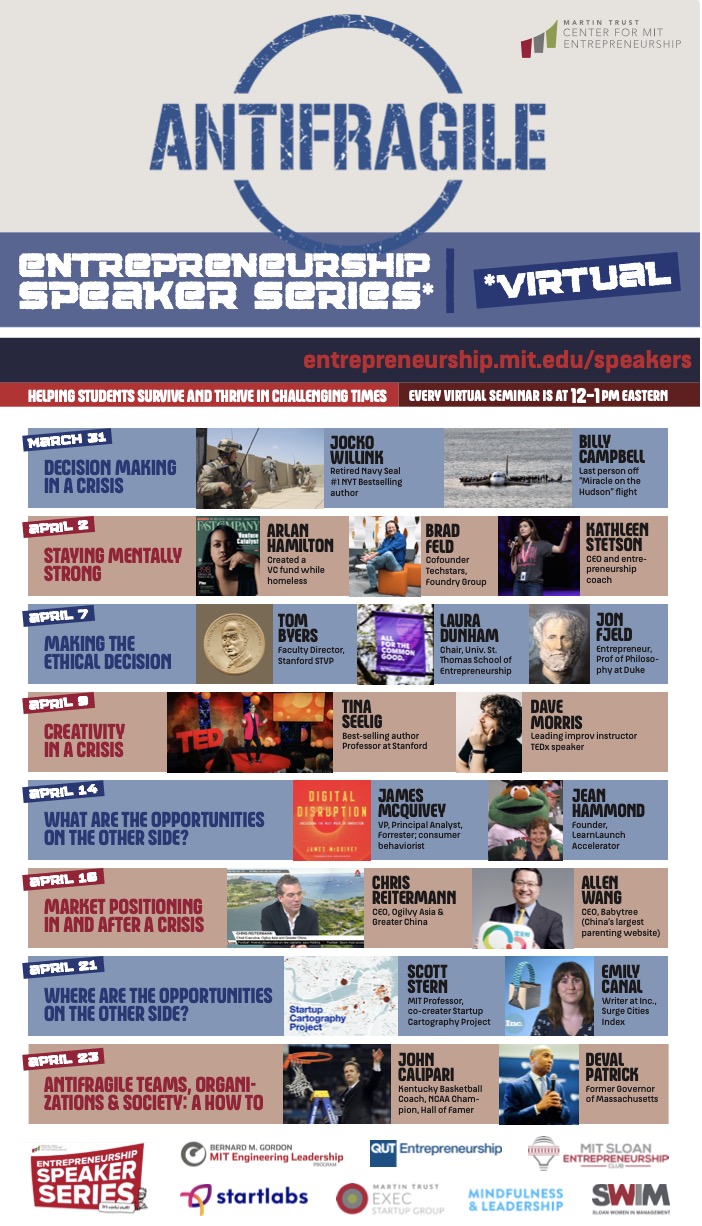
I would also like to acknowledge the following groups for co-sponsoring this event with the Martin Trust Center for MIT Entrepreneurship: Queensland University of Technology (QUT) Entrepreneurship, MIT Startlabs student club, MIT Sloan Entrepreneurship Club, Martin Trust Exec Startup Group, MIT Sloan Executive Education, MIT Sloan Women In Management (SWIM) club, MIT Sloan Mindfulness & Leadership Club, MIT Regional Entrepreneurship Acceleration Program (REAP), and the Bernard M Gordon Engineering Leadership Program.
The author
Bill Aulet
A longtime successful entrepreneur, Bill is the Managing Director of the Martin Trust Center for MIT Entrepreneurship and Professor of the Practice at the MIT Sloan School of Management. He is changing the way entrepreneurship is understood, taught, and practiced around the world.

The Disciplined Entrepreneurship Toolbox
Stay ahead by using the 24 steps together with your team, mentors, and investors.
The books
This methodology with 24 steps and 15 tactics was created at MIT to help you translate your technology or idea into innovative new products. The books were designed for first-time and repeat entrepreneurs so that they can build great ventures.

12 ½ minutes with Bill Aulet
Dates
April 17, 2020
10:00am EST
Location
How to attend
Click on the above Zoom link.
Password: 673973
More details
—
Bill Aulet
12 ½ minutes is a new digital, fireside chat developed and delivered by Elevator. Targeting Scotland’s entrepreneurial and business community, we will be running bitesize interviews with leaders from a range of sectors who have faced and overcome challenges. Each will have stories of optimism to tell, sharing business and life lessons. The focus is to inspire and unite individuals as we plan for life beyond adversity.
Join the fireside chat with Bill on Apr 17 at 10:00am EST, on Facebook: https://www.facebook.com/UKElevator/
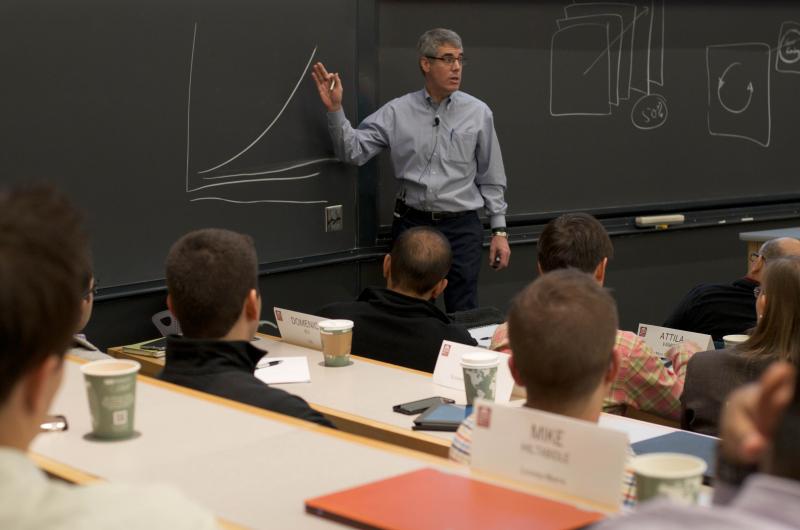
Sign up for our newsletter
The books
This methodology with 24 steps and 15 tactics was created at MIT to help you translate your technology or idea into innovative new products. The books were designed for first-time and repeat entrepreneurs so that they can build great ventures.

